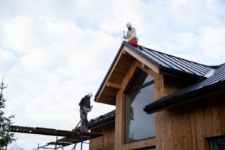
Roof Replacement 101: What You Need to Know

Embarking on a roof replacement project can seem overwhelming, but with the knowledge, you can navigate the process confidently. A sturdy roof above your head provides safety, comfort, and energy efficiency.
What You Need to Know About Roof Replacements
Roof replacement is a substantial home improvement venture that requires careful planning and execution. From knowing when it’s time to replace your roof to understanding the intricacies of materials, costs, and installation processes, there’s much to consider.
Know When It’s Time for Replacement
The lifespan of a roof varies widely depending on the materials used, the installation, and exposure to harsh weather conditions. Common signs that indicate it’s time for a new roof installation include frequent leaks, missing or broken shingles, sagging, and daylight peeking through the roof boards. If your roof is over 20 years old, it’s wise to consider replacing it.
Choosing the Right Material
Roofing materials range from asphalt shingles, the most popular option due to their cost-effectiveness and versatility, to more durable but expensive alternatives like metal, slate, and clay tiles. Each material has pros and cons regarding lifespan, appearance, and climate suitability. Research and consult with professionals to select the premium material that meets your needs and budget.
Find a Reputable Contractor
The success of your roof replacement largely depends on the contractor you choose. Look for licensed, insured, and experienced roofing contractors with solid references and a track record of quality workmanship. Ask for multiple quotes with detailed estimates. Don’t hesitate to question their process and materials.
Understand the Costs
The roof replacement cost varies depending on your roof size, the materials selected, and labor costs in your area. Additional factors like removing the old roof, repairing the roof structure, and installing complexities can also affect the price. Get detailed estimates from several contractors to understand the full scope of the costs involved.
Prepare for Installation
Roof replacement can be messy and noisy. Prepare your home by removing or covering items in the attic, securing loose items on walls and shelves, and considering arrangements for pets during installation days.

Let your contractor know the project timeline and what to expect regarding noise and property access.
Know the Warranty and Maintenance
Understanding the warranty your contractor and the roofing materials manufacturer offers is crucial. Ensure you know what’s covered, the warranty duration, and the maintenance required to keep the warranty valid. Regular inspections and proper maintenance can prolong the life of your new roof.
Permits and Inspections
Most localities require permits for roof replacement projects. Your contractor should handle the permit process but confirm that all necessary permits are obtained before work begins. Inspections may also be required to ensure the installation meets local building codes.
Consider Energy Efficiency and Ventilation
A well-ventilated and energy-efficient roof can significantly reduce heating and cooling costs.

Discuss options like cool roofing materials, proper attic insulation, and ventilation with your contractor to enhance your home’s energy efficiency.
Replacing Your Roof
A roof replacement project, while significant, doesn’t have to be overwhelming. Armed with the right information and a trustworthy team, you can ensure a smooth process and enjoy peace of mind with a secure, durable, and efficient roof over your head.
- Regularly inspect your roof and be aware of signs that indicate the need for replacement.
- Choose roofing materials that balance cost, durability, and appearance suited to your climate.
- Select a reputable, experienced roofing contractor with the necessary licenses and insurance.
- Understand the full scope of costs involved in a roof replacement project.
- Prepare your home and family for the installation process.
- Familiarize yourself with warranty and maintenance requirements to protect your investment.
- Ensure proper permits and inspections are completed according to local regulations.
- Opt for energy-efficient materials and ensure adequate ventilation to save on future energy costs.



















































































